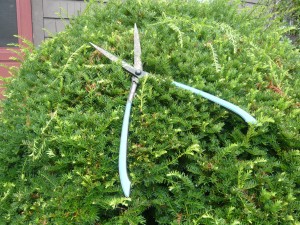Keeping Hedges Looking Good
If you haven’t gotten your hedge clippers out yet this season, it’s not too late to do some work on hedges. And even if you have done some trimming, this is a good time for a tune-up. You can keep hedges to a constant size, but it requires some work once or twice a year – every year.
I recently worked on a barberry hedge that had been given a buzz cut with electric clippers last summer, and again this spring. The job last summer was to bring down the height of the hedge by a foot or more, which meant that most foliage was cut off. It looked pretty gawky, like a teenage boy in shorts, all leg. But I knew that would not seriously harm a barberry. Barberries are tough as nails, almost impossible to kill. They are also on the invasive species list in most states.
I decided to use old fashioned hedge clippers, the manual kind, to work on this hedge. I like them because, unlike the powered ones, you can’t do much damage, or at least not quickly. These look like big scissors with 14-inch blades. My goal was to snip off the 6 to 8-inch new shoots that had popped up erratically since its last pruning in May or early June. I wanted to contain the hedge, not change its basic size or shape.
One of the first things I did was to cut out dead branches. These were most prevalent down low, branches that had been shaded out. Then I looked it over to see what kinds of other things had invaded the hedge since its planting. Hedges are great places for birds to rest and nest, away from hungry cats and foxes. That means that birds also drop seeds near hedges, seeds that go through their digestive systems unharmed – and start new plants.
There is an invasive introduced rose called the multiflora rose. These were introduced by highway departments back in the 1950’s, before people understood their potential to take over the understory. Sure enough, there was a multiflora rose that had grown 3 feet above the top of the hedge – in just a couple of months! I crawled into the hedge and cut it off at the base. If I’d been more courageous I would have dug the roots out, too, but that barberry is a pretty prickly customer.
Then I snipped off all new growth that had grown up since its last haircut. I like a hedge that is quite even, so in low spots along the top or holes along the sides I let new growth remain, or trimmed it lightly to encourage it to branch out.
Experts tell us that a hedge is healthiest if it is tapered: it should be narrowest at the top and spread wider as it gets to the ground. That way all the branches get sunshine, even the lowest ones. But most people don’t trim their hedges that shape, so the lower branches die out from lack of sunshine. Hedges spread out at the top, so that before long they are shaped like a “V” – unless you really work at preventing that.
I called Cal Felicetti, a consulting arborist who works for Chippers, Inc in Lebanon, NH and asked him how much a hedge needs to taper. He said an 8-foot tall hemlock hedge should be about a foot wider at the bottom than it is at the top. That way, not only do all branches get sunshine, the hedge sheds snow better – particularly if the top of the hedge is gently rounded. Stand at the end and look down the hedge, he said. The taper should be obvious, and the lines straight.
Cal also said that if you have a tall hedge, consider investing in a good orchard ladder. These ladders have a hinged leg that you can plunk right into the hedge, allowing you to get to the top of the hedge and do a good job of shearing it. A standard step ladder puts you far away from the top of the hedge, encouraging you to take risks leaning over to reach it – or to just give up.
Cal’s last bit of advice was to buy good tools and keep them sharp. I agree. If you buy good tools they’ll last a life time, and longer. Pruning tools need regular sharpening, but once you learn how to do it, it’s easy.
If you like a formal looking hedge, prune now or even later. Hedges are pretty much done growing until next spring, so they’ll stay smooth and even. If you like a more informal look, prune earlier next year and allow your hedges to get fuzzy all over. The main thing is consistency- you can’t afford to skip a year or two, and hope to catch up later. And remember to taper those hedges, they need to be widest at the base.
Henry Homeyer is the author of 4 gardening books. His Web site is www.Gardening-guy.com.




